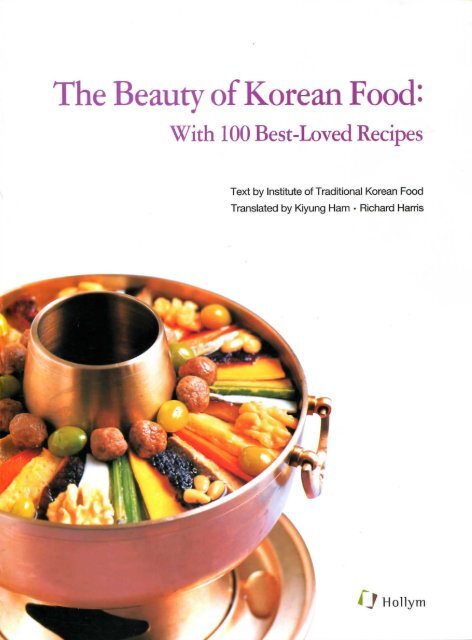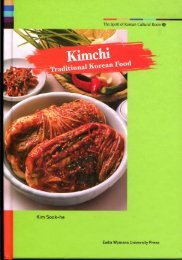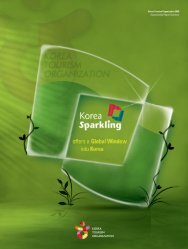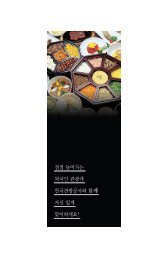The Beauty of Korean Food
The Beauty of Korean Food
The Beauty of Korean Food
- No tags were found...
Create successful ePaper yourself
Turn your PDF publications into a flip-book with our unique Google optimized e-Paper software.
<strong>The</strong> <strong>Beauty</strong> <strong>of</strong> <strong>Korean</strong> <strong>Food</strong>:With 100 Best-Loved RecipesText by Institute <strong>of</strong> Traditional <strong>Korean</strong> <strong>Food</strong>Translated by Kiyung Ham· Richard Harrisf ] l-lollym
<strong>The</strong> Research and Development Project for the Standardization <strong>of</strong> <strong>Korean</strong> Cu isine<strong>The</strong> <strong>Beauty</strong> <strong>of</strong> <strong>Korean</strong> <strong>Food</strong>: With 100 Best-Loved RecipesCopyright © 2007by Institute <strong>of</strong> Traditional <strong>Korean</strong> <strong>Food</strong>Ministry for <strong>Food</strong>, Agricu~ure , Forestry & Fisheries, Republic <strong>of</strong> KoreaMinistry <strong>of</strong> Culture, Sports & Tourism, Republic <strong>of</strong> KoreaAll rights reserved.First published in 2007Tenth printing, 2011by Holiym Intemational Corp., USAPhone 908 353 1655 Fax 908 353 0255http://www.hollym.com e-Mail contact@hollym.comfJ HollymPublished simultaneously in Koreaby Hollym Corp., Publishers, Seoul, KoreaPhone +82 2 734 5087 Fax +8227305149http://www.hollym.co.kr e-Mail info@holiym.co.krSponsored by Ministry for <strong>Food</strong>, Agricu~ure, Forestry & Rsheries andMinistry <strong>of</strong> Culture, Sports & Tourism, Republic <strong>of</strong> KoreaPhoto by Masu Jeong, Gyeongho BaekISBN: 978-1 -56591-253-3Ubrary <strong>of</strong> Congress Control Number: 2007941002Printed in Korea• This book is the results <strong>of</strong> the "Research and Development Project for Standardization <strong>of</strong> <strong>Korean</strong> Cuisine" acheved by Instrrute <strong>of</strong> T radrtional<strong>Korean</strong> <strong>Food</strong> with the supports <strong>of</strong> Ministry <strong>of</strong> <strong>Food</strong>. Agriculture, Forestry & FISheries and Ministry <strong>of</strong> Cu~ure, Sports & Tourism. Republic <strong>of</strong> Korea .• All the copyrights <strong>of</strong> the contents (articles & photographies) <strong>of</strong> this book are reserved to InlStitute <strong>of</strong> T raditionaJ <strong>Korean</strong> <strong>Food</strong> and Ministry for <strong>Food</strong>, Agriculture,Forestry & Fisheries and Ministry <strong>of</strong> Culture, Sports & Tourism, Republic <strong>of</strong> Korea. Without pre-permission <strong>of</strong> copyright hckJers, none <strong>of</strong> any part <strong>of</strong> this bookcould be copied.
CONTENTSForeword ..Preaface .05······· ·07CHAPTER IAN OVERVIEW OFKOREAN FOODCHAPTERllSTANDARD RECIPES FOR 100KOREAN FOOD1. <strong>The</strong> Culture <strong>of</strong> <strong>Korean</strong> <strong>Food</strong> 122. <strong>The</strong> Ingredients <strong>of</strong> <strong>Korean</strong> <strong>Food</strong> ' ........ 153. <strong>The</strong> Kinds <strong>of</strong> <strong>Korean</strong> <strong>Food</strong> ·· ............ 214. Table Settings for <strong>Korean</strong> <strong>Food</strong> .. ·· 245. Regional <strong>Korean</strong> <strong>Food</strong> .. . ..................... 286. <strong>Korean</strong> Table Manners " ····· ······ ·· 31CHAPTER IITHE BASICS OF COOKINGKOREAN FOOD1. Measuring . . ..... 342. Adjusting Heat ..... ....... .. 363. Cutting . . ........................................... 374. Preparing Basic Ingredients ······················ 405. Cooking Basic Broth ............................... 436. Preparing Basic Seasonings ··· ···· ·· ·· · 447. Preparing Garnishes .................. ..... ·· ··· ·· 45-Notes .. ······ 48-Introduction <strong>of</strong> Nutrients .................... .. ........... 49-Ingredients Weight Table ·-Seasonings for Standard Cooking ··-Specification <strong>of</strong> Cooking Utensils "··· ···50·· · 52·· ···· 531. Main DishesBap (Cooked Rice) . ···· 56Huinbap, Ogokbap, Yeongyang-do/sotbapBibimbap, Janggukbap, KimbapJuk (Porridge) ... ·························· 68Kongjuk, Patjuk, Jatjuk, Hobakjuk, JanggukjukJeonbokjuk, HeugimjajukGuksu (Noodles) .. ··············· 82Guksu - jangguk, Haemu/-ka/guksu, /{ong-guksuMu/- naengmyeon, Bibim-naengmyeonMandu (Dumplings) ... ············· 92Mandutguk, Pyeonsu, EomanduTteokguk (Sliced Rice Cake Pasta Soup) .... 98Tteokguk2. Side DishesGuk(Soup) .. ·· 100Bugeotguk, Jogaetang. Miyeokguk, Mu- ma/geunjanggukGa/bilang, Seolleongtang, Samgyelang, YukgaejangimjasulangJjigae (Stew) ' ....... .......... .............. 118Doenjang-jjigae, Gegamjeong. Sundubu - jjigaeGu/dubu- jjigae, /{imchi- jjigaeJeongo/ (Hot Pot) ··................................... 128Domimyeon, Dubu-jeongo/, Beoseol- jeongo/Sinseollo, Eobok- jaengbanJjim (Steamed Dish) "Soe-ga/bijjim, Da/{jjim, Daehajjim, Tteo/0im·· 138
Seon (Steamed Stuffed Vegetables)Oiseon·· ·· 146Janggwa (Seasoned and Braised Seafood) ..... 204Samhap- janggwaSukchae (Parboiled Vegetables) . ·· ·· ········ 148Sigewnchi-namui, Beoseot- namui, Gllieoip'lnJapchae, T angpyeongchaeSaengchae (Fresh Salad) ............................. 158Deodeok- saengchae, Chamnamui-saengchaeGyeojachae, Dotorimuk-muchimJorim (Braised Dish) .··· ·· ·· 166Soegogi-jangjorimJangajji (Pickled Vegetabes)····· 206A1aneui - jangajjiJeotggal (Sa~-fermented Seafood) H. 208OjingeojeotKimchi (Kimchi) ......... ............... ....................... 210Baechu- kimchi, Baekkimchi, BOS5'lf)]-kimchiChonggak- kimchi, Kkakdugi, Nabak-kimchiJangl
CHAPTER I.AN OVERVIEW OFKOREAN FOOD1. <strong>The</strong> Culture <strong>of</strong> <strong>Korean</strong> <strong>Food</strong>2. <strong>The</strong> Ingredients <strong>of</strong> <strong>Korean</strong> <strong>Food</strong>3. <strong>The</strong> Kinds <strong>of</strong> <strong>Korean</strong> <strong>Food</strong>4. Table Settings for <strong>Korean</strong> <strong>Food</strong>5. Regional <strong>Korean</strong> <strong>Food</strong>6. <strong>Korean</strong> Table Manners
1. THE CULTURE OF KOREAN FOODWith four distinct seasons in the temperate zone, Korea produces a variety <strong>of</strong> seasonal ingredients such as grains,beans, vegetables and seafood. Main dishes and banchan (side dishes) were created with those ingredients as werestorable, fermented foods such as fermented sauce, Kimchi (salted fermented vegetables) and salt-fenllented seafood.As sharing seasonal food with neighbors was a custom, sisi/{ (seasonal food) and jeo/si/{ (festival food) thrived, andregional specialties made with local products also developed. In terms <strong>of</strong> topography, mountains and fields are spreadout over the country, and Korea is surrounded by sea on three sides. <strong>The</strong>refore, marine products are abundant and<strong>Korean</strong>s have been farming rice and hunting since early times.Mae/{jo/{ who immigrated to Korea from Middle Asia around the time <strong>of</strong> the Old Stone Age (before 3000 B.C.), wasthe forefather <strong>of</strong> Korea. It is believed that the tradition <strong>of</strong> eating cooked rice as a staple and band1an such as I\imchias a side dish had started from the later part <strong>of</strong> the Three Kingdoms (SiUa, Bae/{je, Goguryeo) era (late 6th - 7thcentury B.C.) when <strong>Korean</strong> ancestors lived in a community. In the unified Silla era (676 - 935 A.D.), the consumption<strong>of</strong> meat declined, and dishes with tea and vegetables were preferred due to Buddhism. In the Goryeo Dynasty (935 -1392 A.D.), active trade with northem countries brought salt, black pepper and sugar to GOlyeo, and famous <strong>Korean</strong>dishes such as Goryeo-ssam (lettuce wraps) and GOIyeo-byeollg (ya/{gwa, a sweet cake) were taken to China.In the Joseon Dynasty (1392 - 1910 A.D.), Confucianism was predom inant. Based on the idea <strong>of</strong> devotion to parents,the culinary tradition <strong>of</strong> serving ancestors in a patriarchal system was considered to be extremely important. Thattradition extends to the <strong>Korean</strong> way <strong>of</strong> eating now. <strong>The</strong> culture <strong>of</strong> <strong>Korean</strong> food, hamlonized with nature, and socialand cultural environments, has developed a cuisine that promotes seasonal and regional characteristics, which are asfo llows:A. Main dishes and side dishes have been developed independently.Main dishes such as bap (cooked rice), ju/{ (porridge), tteo/{gu/{ (sliced rice pasta soup) , sujebi and mandu (dumplings)are accompanied with side dishes that provide a balanced meal.B. Various kinds <strong>of</strong> dishes and recipes<strong>The</strong>re are various kinds <strong>of</strong> dishes such as cooked rice, soups, salads, and diverse cooking methods such as grilling,boiling, blanching, steaming, frying and braising.C. Varieties <strong>of</strong> taste and appearanceVarious seasonings are added during cooking to evoke typical <strong>Korean</strong> flavors. Nuts. eggs and/or mushrooms areadded as gam ish to make the food visually appealing.D. <strong>The</strong>re are two notions about <strong>Korean</strong> food, which are eumyangohaeng (the doctrine <strong>of</strong> thefive natural elements <strong>of</strong> the positive and negative) and yaksikdongwon (food and medicine are<strong>of</strong> the same origin).Based on the doctrine <strong>of</strong> eumyangohaeng, ingredients or gam ishes in five colors are used in the food, and the concept<strong>of</strong> ya/{si/{dongwon is evident in the recipes.12 . <strong>The</strong> <strong>Beauty</strong> <strong>of</strong> <strong>Korean</strong> <strong>Food</strong>
E. All dishes are served on one table at the same time. All the table settings have beendeveloped based on the table setting for one person.Prepared dishes are served on one table at the same time. <strong>The</strong>re are 3, 5,7,9 and 12- course table sett ings, but all thetable settings are based on the setting for one person.F. Regional food, seasonal food and storable, fermented food have been developed.<strong>The</strong>re are varioLis local specialties from every region. Regional food and seasonal food made with those specialtieshave been enjoyed, and several fermented foods made <strong>of</strong> seasonal ingredients such as soy sauce, soybean paste, saltfermentedseafood and Kimchi have been developed.G. <strong>The</strong> food for initiation ceremonies and table manners has been developed.Under the influence <strong>of</strong> Confucianism, food for festivals and rituals such as for the first birthday, marriage, funeral ritesand ancestor memorial ceremony, has been developed.Folding Screen <strong>of</strong> Feast Celebrating the 60th Wedding Anniversary, Painter- Unidentified,Joseon, 18 th Century, (33.5 em x 45.5 em) National Museum <strong>of</strong> KoreaGeneral Observation <strong>of</strong> <strong>Korean</strong> <strong>Food</strong> . 13
Non-glutinous Rice Glutinous Rice Brown Rice Black RiceWheat Bar1ey Buckwheat Foxtail MilletChinese Millet African Millet Red Beans Mung beans..,~ . .. ". ..." ... ,"' •••f... ... -t'e, - -.-.', . ~.', ' .. c;. . , ,.Soybeans Blue Beans Peas Kidney BeansUnripe Beans Cowpeas Geopi- Mung Bean Geopi-PatGrains and Beans14 . <strong>The</strong> <strong>Beauty</strong> <strong>of</strong> <strong>Korean</strong> <strong>Food</strong>










